Introduction
From the beginning one
of our major emphasis here at TBGI has been helping the beginning bass
fisherman by providing good solid information
that will help them when they are on the water. But no matter how much
information we provide there is one essential element that the beginning
fisherman must supply himself and that is “A Positive Attitude” when
learning new techniques. I believe this is especially true when it comes
to learning how to fish plastics. Truthfully this is one of the easiest
methods to learn and many times can very deadly. If you will focus on
the basics and think positively you can become a good plastics fisherman.
I appreciate Shay sharing with us some of his thoughts and techniques
on fishing plastic baits. As we have discussed in previous articles every
one has a “Go To Bait” that produces for them. For Shay
it is fishing plastics which he is an expert at using. It is our hope
that
this article will help you put more bass over the rail on their next
fishing trip. Rick McFerrin
Equipment
This is one area that the
beginning bass fisherman wants to make sure that they are spending
their money wisely. Maybe you have heard
the phrase “Specialty
Rods”. What this means is that rod manufactures like AllPro Rod
Company produce rods that are designed for a specific purpose or technique.
Top Water Rods-Crankbait Rods-Ultra Light Rods-Float N Fly Rods-SpinnerBait
Rods-Worm Rods-Flipping Rods-Carolina Rig Rods and the list go’s
on.
Shay’s best advice for the beginner learning to fish plastics
is to buy the best most sensitive rod they can afford designed specifically
for fishing plastic baits. Next is a list of the rods that Shay use’s
which work best for him. (1) For plastic worm fishing Shay uses either
a 6 1/2ft or a 7ft medium heavy to heavy action rod and a 6:3:1 baitcasting
reel loaded with 15lb or 20lb “Good Quality” fluorocarbon
line. (2) When fishing a Carolina Rig Shay uses 7ft medium heavy to heavy
action rod and the same reel. We will discuss line later for this technique.
(3) When Shay is “Flipping” or “Pitching” he
uses a 7 ½ ft or a 8ft heavy action rod with the same 6:3:1
bait casting reel and 25lb test fluorocarbon line. Make sure that you
buy
a rod with a telescoping handle so it will fit into your boat and vehicle.
To help you make a good choice when buying a rod visit www.allprorods.com on our links page..
Choosing Worm Or Lizzard Colors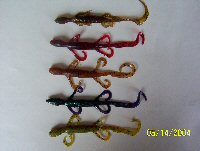
 When
looking at plastic worms-French fries-lizards and other plastic baits,
if I said there is a rainbow of colors to choose from I wouldn’t
be stretching it bit. Here are some basic colors that will works for
Shay day in-day out in our middle Tennessee Lakes. There are many other
colors that will work as well-but just go slow and choose wisely. As
far as worm length you can stay with a 6inch or 7 inch worm in most of
our lakes. That doesn’t mean that you won’t catch fish on
a 10 inch worm-or on a 4 inch worm but Shay has found that the 6 & 7
inch worms produce more strikes over the course of the day.
When
looking at plastic worms-French fries-lizards and other plastic baits,
if I said there is a rainbow of colors to choose from I wouldn’t
be stretching it bit. Here are some basic colors that will works for
Shay day in-day out in our middle Tennessee Lakes. There are many other
colors that will work as well-but just go slow and choose wisely. As
far as worm length you can stay with a 6inch or 7 inch worm in most of
our lakes. That doesn’t mean that you won’t catch fish on
a 10 inch worm-or on a 4 inch worm but Shay has found that the 6 & 7
inch worms produce more strikes over the course of the day.
Clear Water: Green Pumpkin-Pumpkin Seed-RootBeer-Black and Black/Blue
are Shay’s choices. In clear water don’t overlook a slim
straight tailed worm. These fall a little faster and the fish can see
them easily.
Dingy Water: Red Bug-June Bug-Electric Purple and
Electric Blue are Shays
Favorites. In dingy to muddy water opt for a
fatter ribbon tailed worm
that will produce more under water vibrations which the fish will feel
many times before they can see them.
Specialty Worms: Colors for floating
worms-trick worms and wacky worms range from white-bubblegum-cotton
candy and yellow.
Choosing Hooks
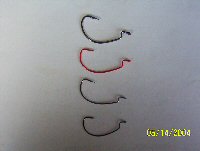 As
far as hooks are concerned, Shay uses 1/0-2/0-3/0-4/0 and 5/0 wide
gap hooks based on the size of the plastic bait he is
using and
the structure
he is fishing. Be sure that you don’t over power the baits you
are using with hooks that are to large. Hooks are manufactured in “Light
Wire” and “Heavy Wire”. A good rule of thumb when selecting
the right hook is (1) Heavy cover/structure-Heavy Line-Heavy Plastic
baits…..Heavy Wire Hooks. (2) Spinning tackle with lighter line
and lighter baits…..Light Wire Hooks.
As
far as hooks are concerned, Shay uses 1/0-2/0-3/0-4/0 and 5/0 wide
gap hooks based on the size of the plastic bait he is
using and
the structure
he is fishing. Be sure that you don’t over power the baits you
are using with hooks that are to large. Hooks are manufactured in “Light
Wire” and “Heavy Wire”. A good rule of thumb when selecting
the right hook is (1) Heavy cover/structure-Heavy Line-Heavy Plastic
baits…..Heavy Wire Hooks. (2) Spinning tackle with lighter line
and lighter baits…..Light Wire Hooks.
Choosing Sinkers

 Shay
uses a bullet shaped slip sinker most of the time when worm fishing and
allows the
sinker to slide free up and down the line. The
reason
behind this it reduces the potential of the fish throwing the
bait when they jump. An exception to this is when Shay is fishing heavier
cover
then he will “Peg” the sinker to the head of the worm.
There are a couple ways that you can “Peg” a worm. One
is by forcing a tooth pick into the bottom hole of the sinker. The
Shay
uses a bullet shaped slip sinker most of the time when worm fishing and
allows the
sinker to slide free up and down the line. The
reason
behind this it reduces the potential of the fish throwing the
bait when they jump. An exception to this is when Shay is fishing heavier
cover
then he will “Peg” the sinker to the head of the worm.
There are a couple ways that you can “Peg” a worm. One
is by forcing a tooth pick into the bottom hole of the sinker. The  only
problem with
this is that you run the risk of damaging your line. A better choice
is to use a product like T-Stops which are made of rubber and pulls
through the sinker holding it in place without damaging your line.
This helps
the lure not become hung as easily on brush. When Carolina Rigging
Shay uses a “Egg Sinker” in weights from 3/8oz to a full
1oz. The reason for the heavier sinker it helps you feel the bottom
better.
We will address this further in the Technique Section.
only
problem with
this is that you run the risk of damaging your line. A better choice
is to use a product like T-Stops which are made of rubber and pulls
through the sinker holding it in place without damaging your line.
This helps
the lure not become hung as easily on brush. When Carolina Rigging
Shay uses a “Egg Sinker” in weights from 3/8oz to a full
1oz. The reason for the heavier sinker it helps you feel the bottom
better.
We will address this further in the Technique Section.
Let’s Talk About Techniques
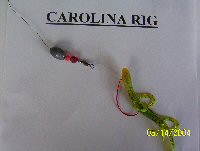 Fishing
a Carolina Rig: Shay explains that this technique has proven to be
deadly over and over again for him. Just to review-Shay uses
a 7ft Heavy action rod-6:3:1 casting reel and 20lb P-Line fluorocarbon
as the main line and 12lb to 15lb test P-Line as the leader. (See Picture
of Shays Carolina Rig) The difference between a Texas rig which we
will
cover next and a Carolina rig is simple. The Texas rig will take the
plastic bait to the bottom because the sinker remains close to the
head of the bait when you cast. The Carolina rig on the other hand
will let
the plastic worm-Lizard-French Fry etc float or swim above the bottom
on an attached leader because the sinker is kept higher upon the line
through the use of an attached swivel. Shay adds glass beads that will
make a “Clicking Sound” as you drag the sinker across the
bottom helping gain the attention of bass in the immediate area. Once
again the weight of the egg sinker will depend upon the depth of the
water and wind conditions. To make this technique work for you there
must be sinker contact with the bottom at all times. After you cast
begin to sweep your rod to the side and drag the bait along. When you
feel
a hit-reel down on the bass and set the hook.
Fishing
a Carolina Rig: Shay explains that this technique has proven to be
deadly over and over again for him. Just to review-Shay uses
a 7ft Heavy action rod-6:3:1 casting reel and 20lb P-Line fluorocarbon
as the main line and 12lb to 15lb test P-Line as the leader. (See Picture
of Shays Carolina Rig) The difference between a Texas rig which we
will
cover next and a Carolina rig is simple. The Texas rig will take the
plastic bait to the bottom because the sinker remains close to the
head of the bait when you cast. The Carolina rig on the other hand
will let
the plastic worm-Lizard-French Fry etc float or swim above the bottom
on an attached leader because the sinker is kept higher upon the line
through the use of an attached swivel. Shay adds glass beads that will
make a “Clicking Sound” as you drag the sinker across the
bottom helping gain the attention of bass in the immediate area. Once
again the weight of the egg sinker will depend upon the depth of the
water and wind conditions. To make this technique work for you there
must be sinker contact with the bottom at all times. After you cast
begin to sweep your rod to the side and drag the bait along. When you
feel
a hit-reel down on the bass and set the hook.
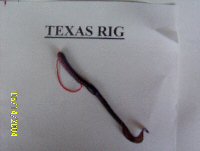 Fishing A Texas Rig: Shay explained that he likes to use this method
in and around rocky banks-boat docks and log jambs. Sinker size once
again will be determined by the depth of the water and will always
be a bullet sinker. Shay uses a 6 ½ and 7ft rod with a 6:3:1 bait
casting reel and 15lb to 20lb test line. Shay tries to bounce the worm
or lizard off of everything possible to attract a bass. Shay stresses
the importance of keeping your rod directly in front of you at a 45 degree
angle. At times Shay will move the worm slowly along the bottom other
times he will retrieve it with a “Twitch” giving it an
erratic movement. Another key Shay stressed was keeping concentration
on what
your doing. Sometimes the bite will be vicious-at other times it will
be ever so light. But when you detect a bite reel the slack out of
your line and set the hook.
Fishing A Texas Rig: Shay explained that he likes to use this method
in and around rocky banks-boat docks and log jambs. Sinker size once
again will be determined by the depth of the water and will always
be a bullet sinker. Shay uses a 6 ½ and 7ft rod with a 6:3:1 bait
casting reel and 15lb to 20lb test line. Shay tries to bounce the worm
or lizard off of everything possible to attract a bass. Shay stresses
the importance of keeping your rod directly in front of you at a 45 degree
angle. At times Shay will move the worm slowly along the bottom other
times he will retrieve it with a “Twitch” giving it an
erratic movement. Another key Shay stressed was keeping concentration
on what
your doing. Sometimes the bite will be vicious-at other times it will
be ever so light. But when you detect a bite reel the slack out of
your line and set the hook.
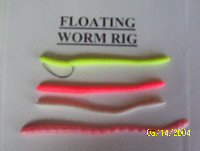 Fishing A Floating Worm: This is perhaps one of the most enjoyable
ways to fish a worm. The visual strikes this method produces at times
is breath taking. As we discussed in the choosing worm color section
Shay uses a variety of colors which include White-Bubblegum-Cotton
Candy and Yellow. Floating worms or trick worms can be fished on bait
casters
or spinning gear equally as well. One major key to fishing this method
correctly is finding out what the fish want. At times they want a floating
worm that is moving like a snake-at other times they want bait that
is moving slow and easy. To rig a “Floating Worm” you attach
the hook in the same manner as a Texas rigged worm. To rig a “Wacky
Worm” the hook is attached in the center of the worm and left
exposed. Shay stressed there is just about no wrong way to use this
technique.
Fishing A Floating Worm: This is perhaps one of the most enjoyable
ways to fish a worm. The visual strikes this method produces at times
is breath taking. As we discussed in the choosing worm color section
Shay uses a variety of colors which include White-Bubblegum-Cotton
Candy and Yellow. Floating worms or trick worms can be fished on bait
casters
or spinning gear equally as well. One major key to fishing this method
correctly is finding out what the fish want. At times they want a floating
worm that is moving like a snake-at other times they want bait that
is moving slow and easy. To rig a “Floating Worm” you attach
the hook in the same manner as a Texas rigged worm. To rig a “Wacky
Worm” the hook is attached in the center of the worm and left
exposed. Shay stressed there is just about no wrong way to use this
technique.
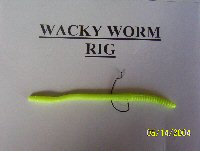 Flipping And Pitching: We need to begin by explaining the difference
between “Pitching” and “Flipping”. Pitching
is a long distance version of flipping. Shay uses an underhand flip
cast
when pitching keeping the bait as close to the water as possible. This
method Shay explains is awesome when the fish are very shallow and
you want to avoid spooking the fish by getting to close to them. At
times
you may have to make several long pin point pitches to the same spot
and you crawl the bait back toward you. Concentration once again is
critical at all times. This method allows you to fish thick cover that
might be
unfishable in any other manner. On the other hand when flipping you
get as close to the fish as possible. You make far shorter flips and
you
are working the bait up and down in a vertical manner as you climb
your bait through the limb and branches. Once again watch your line
and keep
your concentration. Plastics are normally rigged in a Texas rig manner
and sinkers are pegged against the head of the worm. Shay uses a 7
1/2ft or 8ft heavy action rod a 6:3:1 bait casting reel and 25lb test
line
for this method.
Flipping And Pitching: We need to begin by explaining the difference
between “Pitching” and “Flipping”. Pitching
is a long distance version of flipping. Shay uses an underhand flip
cast
when pitching keeping the bait as close to the water as possible. This
method Shay explains is awesome when the fish are very shallow and
you want to avoid spooking the fish by getting to close to them. At
times
you may have to make several long pin point pitches to the same spot
and you crawl the bait back toward you. Concentration once again is
critical at all times. This method allows you to fish thick cover that
might be
unfishable in any other manner. On the other hand when flipping you
get as close to the fish as possible. You make far shorter flips and
you
are working the bait up and down in a vertical manner as you climb
your bait through the limb and branches. Once again watch your line
and keep
your concentration. Plastics are normally rigged in a Texas rig manner
and sinkers are pegged against the head of the worm. Shay uses a 7
1/2ft or 8ft heavy action rod a 6:3:1 bait casting reel and 25lb test
line
for this method.
Conclusion
I want to thank Shay again
for sharing this information with us and our hope is that it will make
you a better plastics fisherman. If you
have additional questions please feel free to ask Shay by using our “Fish
Report” forum we will be happy to help in any manner we can.
Thanks again Rick McFerrin Owner www.tennesseebassguides.com
More Tips by Tennessee
Bass Guides
Tennessee Bass Guides
Tennesseebassguides.com

